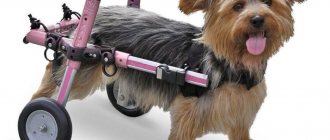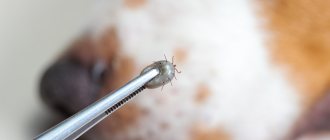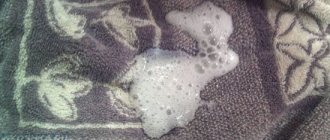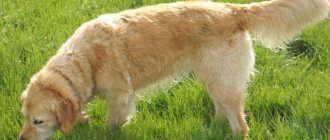Brain lesions occur in dogs much less frequently than in people, but lead to no less dire consequences. In addition, this condition is much easier to ignore, because the animal cannot complain about a deterioration in its health and a headache.
Therefore, owners of four-legged pets should know well what to do in such a critical situation. The health and even life of the pet largely depends on how quickly and correctly the owners react.
Can a dog have a stroke?
Poor blood circulation in the brain in dogs is a fairly rare pathology. This is explained by the fact that animals do not drink alcohol or fatty foods that increase cholesterol levels. The possibility of the disease cannot be completely excluded, since the cardiovascular system works worse with age. Stroke is difficult to diagnose. If you do not see a doctor in time, death is possible.
The following forms of stroke are diagnosed in dogs:
- Ischemic. The main reason is mechanical blockage of blood vessels. Most often, ischemic stroke occurs due to blood clots formed in the vessels. This disease is common in older dogs. At risk are pets with increased emotional excitability, leading a sedentary or overly active lifestyle.
- Embolic. In this case, the blood clot does not form in the brain, but in the heart or other organs.
- Hemorrhagic. Increased pressure leads to rupture of blood vessels, resulting in hemorrhage. It negatively affects surrounding tissues.
Please note: circulatory problems most often occur in large breed dogs.
Complications of the disease
The older the affected pet and the more severe the brain damage, the more pronounced the consequences of a stroke will be.
After suffering brain damage, a dog may experience worsening:
- hearing;
- vision;
- functioning of the limbs (lameness, paralysis);
- in severe cases, urinary incontinence may occur.
A dog who has suffered a stroke should undergo regular examinations by a specialist, twice a year. It may include blood and urine tests, EEG, ultrasound, ECG.
Emergency therapy is carried out in the first hours and days of the disease and is aimed at stabilizing the heart.
What can cause a stroke in a dog?
There are several main reasons why a pet may have a stroke. Most often, circulatory disorders are caused by physiological and age-related changes, congenital and acquired diseases.
The cause of a stroke can be:
- Hormonal disorders. The problem arises when self-medicating.
- Old age of the pet. Strokes in older dogs are common.
- Overweight and obesity.
- Benign and malignant neoplasms.
- Diseases of the nervous system, kidneys, liver, thyroid gland.
- Increased excitability.
- Sudden stressful and shock situations.
- Heart disease, such as hypertension.
- Bruises and head injuries.
- Infection with parasites, worms.
- Abnormal vascular development from birth.
- Chronic neuroses.
- Diseases leading to blood clotting disorders.
- Intoxication, which is accompanied by profuse vomiting.
- Genetic predisposition.
The main cause of hemorrhagic stroke in dogs is severe poisoning, head injuries and poor blood clotting.
Often, doctors cannot determine the exact cause and form of a stroke. In this case, the animal is diagnosed with “idiopathic stroke.” Since the cause of the circulatory disorder has not been identified, the disease may recur.
What is the disease
Brain lesions in dogs are not as common as in humans. But the results are no less devastating. It is important to notice a stroke in a dog in time, because your furry friend will not complain of poor health or headaches. That's why pet owners should be aware of what to do in such situations. The life and health of the dog will depend on the speed of the owner’s reaction.
Pathology is a violation of cerebral blood supply. Most often the disease occurs in old age. Such a violation is very dangerous, and also difficult to diagnose.
In animals, as in people, there are two forms of the disease:
- Ischemic
. It is characterized by blockage of a blood vessel in the head by a blood clot. In this situation, the forecast is more optimistic. However, the severity of the lesion will depend on the location and size of the clot. In any case, the blood does not fully enter the brain, which deprives the organ of oxygen, and against this background hypoxia occurs.
- Hemorrhagic
. This form is characterized by ruptures of blood vessels. Blood then enters the brain tissue. The effusion of blood forms a hematoma, which puts pressure on the tissues, disrupting their nutrition. This option becomes the root cause of severe consequences: paresis and paralysis. Animals are at risk of dying.
The disease is divided according to the severity of brain damage. If a small area is affected, it is given the status of local; if large areas are involved, it is given the status of extensive. The more global the affected area, the more serious the consequences may be.
There are also micro-variants of stroke in dogs, which represent blockage of small capillaries. The process proceeds unnoticed and practically asymptomatic. This condition is poorly diagnosed, which is dangerous for pets, as it often precedes damage to larger elements of the circulatory system.
“
Embolism is considered a separate form of ischemia. A blood clot that has formed in some other place begins to move through the circulatory system to the head section. There it gets stuck and creates negative consequences.
If small capillaries are affected and the affected area is not in vital areas of the brain, the disease goes away unnoticed by the owner. However, this does not mean that everything is normal and the dog is fine.
When the first alarm signals are detected, action should be taken immediately. It is necessary to thin the blood, eliminate inflammatory processes, prevent the problem from spreading, and try to normalize cerebral circulation. The veterinarian will select the necessary medications for these purposes.
Signs of circulatory disorders: how to identify a stroke in a dog
Only a doctor can diagnose a stroke based on an examination. The first symptoms of circulatory problems in the brain are lethargy and apathy of the dog. The animal sleeps a lot, becomes inactive, and inactive.
The clinical manifestation can be rapid (even death). In other cases, symptoms appear within a few days (usually 1–3).
Signs of stroke in dogs are:
- The animal's muzzle becomes asymmetrical and its tongue protrudes.
- The dog stops responding to the owner’s commands or does not recognize him and becomes aggressive.
- As a result of the disease, the pet develops atrophy of certain muscle groups. Very often dogs can meaninglessly walk in circles and spin around in one place.
- A sick pet develops vision problems and changes in the size of the pupils. The dog may trip over various objects.
- The animal has paralysis of the limbs. Complete paralysis is diagnosed extremely rarely.
- Due to the weakening of the chewing muscles, the pet refuses its usual food.
- The animal experiences convulsions resembling signs of epilepsy.
In case of severe circulatory disorders in the brain, the animal may faint, involuntary urination and defecation occur.
In older pets, vomiting and muscle tone are added to the main symptoms. The whites of the dog's eyes acquire a characteristic reddish tint.
Most often, the signs of a stroke increase over several hours. If one or more symptoms appear, you should not self-medicate and go to the clinic.
Symptoms of the disease
The following signs will help you recognize a stroke in your pet in time and seek help from a veterinarian:
- the dog has become unusually lethargic, apathetic, or, on the contrary, overly active and even aggressive;
- the animal does not respond to its name, as if it does not recognize you, it looks confused;
- the dog has problems swallowing food and water;
- a clear asymmetry appeared on the muzzle;
- the pet begins to limp or lies completely motionless;
- labored breathing;
- convulsions, seizures resembling epileptic ones;
- dilation of one or both pupils;
- vomit;
- coma.
Canine microstroke is not characterized by such striking manifestations. However, if your pet refuses food, behaves strangely, for example, wanders aimlessly in circles around the apartment, refuses to go outside - immediately go to see a doctor.
First aid for stroke in dogs
When the first symptoms of a stroke appear, it is necessary to take the dog to the veterinarian as soon as possible or call a doctor at home.
It is important to provide first aid to the animal:
- Remove the leash and collar.
- Place the dog on its side.
- If the animal vomits, carefully remove the mass from the mouth.
If your pet has had a stroke, you should never:
- Apply cold compresses to the head. Temperature differences will cause the condition to worsen.
- Give a sick animal any medications, including herbal tinctures.
- Make injections. Only a doctor can prescribe treatment based on the results of the examination.
On the way to the clinic, it is important to calm the animal.
Providing independent first aid
Treatment in this case does not require delay - you should immediately get help at home. Even if you worry in vain, help will be useful. The main thing is not to delay it and not cause harm by performing meaningless and unprofessional actions. The best option would be to call the veterinary clinic and provide first aid under the guidance of a doctor.
What can you do with caution?
If you feel like you don't have time to make a call, follow these simple steps
:
- remove the collar and anything that may interfere with breathing and movement;
- Lay the sick person on his side - the head area should be in a comfortable position (in case of nausea);
- if vomiting was observed, then all secretions should be removed from the mouth;
- Talk quietly and kindly to your pet, calming him and stroking him.
Never give medications without a doctor's prescription. You can only use herbal sedatives - again, with the approval of the veterinarian at the other end of the line. The main thing is that the liquid does not enter the respiratory system. Do this with a syringe without a needle.
What is prohibited to do
Some actions of owners can harm the pet, so you should be well aware of what not to do:
- You cannot give water to an animal if it is unconscious or has convulsions, foam at the mouth, or vomiting;
- under no circumstances give any medicines or give injections until the doctor himself says so;
- do not cool the sick person’s head and do not wrap him up to prevent overheating;
- Don’t create panic, noise and fuss: this will only make the situation worse.
Ideally, you should first call the veterinarian, and then carry out the treatment measures that he recommends.
Treatment of stroke in dogs
If your pet has a circulatory disorder in the brain, the doctor will provide emergency care. It is aimed at normalizing the functioning of the cardiovascular system, lungs, and reducing the risk of cerebral edema. Medicines are administered by injection or injections.
The most commonly used treatments for stroke are:
- Drugs that restore the functioning of the heart and blood vessels.
- Medicines that accelerate the removal of fluid from the body (diuretics).
- Antiemetics, steroid drugs.
- Antispasmodics.
- Neuroprotectors, nootropics.
- Sedatives.
- Painkillers.
The first three days after a stroke are considered the most dangerous for the animal. If within 2–5 days the dog is recovering, there is a positive trend, further treatment in the hospital is not required. Therapy can be continued at home. The absence of a positive response to treatment indicates a poor prognosis.
Animals with a severe form of stroke (when swallowing function is impaired) receive nutrition using droppers. After the swallowing function is restored, feeding is carried out using a syringe or rubber bulb.
Remember: a stroke is a serious pathology that requires emergency medical care and treatment in a hospital. Self-medication often leads to death.
Modern approaches to the treatment of disease in veterinary clinics
After all diagnostic measures and a comprehensive examination, the veterinarian will make a diagnosis and only then prescribe treatment. If a stroke is confirmed, the dog will be prescribed anticonvulsants, painkillers, drugs that restore cerebral circulation, vitamins, antipsychotics, and tranquilizers.
Most likely, the animal, especially in serious condition, will remain in the hospital for several days under the supervision of staff. As soon as the patient’s condition has stabilized, he will be discharged home under the responsibility of his owners. Owners will have to strictly follow all doctor's instructions and adhere to the prescribed medication regimen.
Recovery at home
The doctor prescribes medications in the form of tablets or injections. Rehabilitation therapy is carried out using the same medications that were used for emergency treatment. Most often these are blood thinners, diuretics, and nootropics. The duration of the appointment is determined by the doctor.
Many animals are prescribed the drug Cerebrolysin. It accumulates in body tissues, acts slowly, and helps avoid complications after a stroke. Nicotinic acid restores blood circulation. Prozerin is recommended for paralysis. If an animal has lost its appetite due to a stroke, intravenous infusions are given to prevent dehydration.
What not to do!
When providing emergency care, it is important not to make the following mistakes:
- Do not apply cold to your head under any circumstances! Once upon a time this was often recommended. It has now been proven that this action not only does not bring anything useful, but can also cause harm, causing spasm of blood vessels, both already damaged and healthy, worsening the condition after a stroke.
- It is forbidden to try to give any pills without the instructions of a specialist!
- You should not give your dog any injections unless directed by your veterinarian!
Rehabilitation
Rehabilitation after a stroke lasts 1.5 – 2 months. In severe cases, the recovery period can take a year. To help the animal, you must follow all the recommendations of your doctor and take prescribed medications.
During the rehabilitation period it is important:
- Buy hard, warm and dry bedding for your pet. It must be changed when it gets dirty.
- Turn the dog over to prevent the formation of bedsores.
- Treat the animal's skin with special gels, ointments or creams (prescribed by the attending physician).
- Avoid drafts in the room where the animal is located. Cold draft air can cause pneumonia. This is one of the most common complications after a stroke.
- Take prescribed medications regularly.
- If necessary, attend physiotherapeutic procedures. Your veterinarian may prescribe magnetic therapy or electrical muscle stimulation for your dog. If the animal is paralyzed, it is necessary to massage the limbs. Massage is also recommended as a preventive measure (excluding complications from the musculoskeletal system).
- Watch your diet. It is important that your pet’s food is light and has a semi-liquid or liquid consistency. The diet should include lean chicken meat, oatmeal, beef puree, chicken broth, and pureed vegetables. It is better not to change the usual menu: it is important to exclude the consumption of fatty foods. You should also avoid rice and buckwheat cereals. Up to 4–6 meals (small portions) are recommended per day.
Rehabilitation and pet care
In addition to medications, you should properly care for your pet, who is weakened during this period. An animal will recover from illness in an average of two months. There is no guarantee that it will behave the same way as before the disease.
You should strictly follow the doctor’s instructions and give the necessary medications on time. The cardiovascular system, metabolic processes, and blood circulation in the cranial region should be kept under control. It is important to create a calm atmosphere in the home.
Organize a comfortable place for your patient - not too soft, but warm. It is important to change the litter more often and regularly clean it from dirt. If there is paralysis, be sure to turn your pet over to prevent the formation of bedsores.
Paw massage helps a lot. Be sure to treat the stitches if there has been surgery, and make sure your pet doesn’t lick them. A protective collar or blanket is suitable for these trees.
Therapeutic diet
Most likely, during the first couple of days, being in the acute phase, the animal will completely refuse to eat. He will only need water. As soon as the pet feels better, he will want to eat, and a special diet should already be prepared for him.
The main principle of a therapeutic diet after a stroke is to feed often, little by little, and crushed food. Ideally, it will be a puree of boiled lean meat and vegetables. Veterinarians strongly recommend NOT using baby food, but preparing your dog's food yourself.
“If your dog is used to eating dry food, then you need to give it soaked. For the first week you can make do with pates and pouches. There is a high probability that the food will have to be replaced with medicinal food: the brand, quantity and frequency of feeding will be recommended by the attending veterinarian.
On average, the first couple of weeks the dog should eat small meals 5-6 times a day. Once she feels better, you can start adding larger pieces of food, and then completely switch to regular food.
What is the prognosis for recovery?
Unfortunately, no one, not even the most experienced veterinarian, can say for sure how quickly the dog will recover and whether this will happen completely. Some individuals recover quickly, and no trace remains of the stroke, and some retain traces of the illness until the end of their lives.
In any case, at the very beginning of the disease you should not think about this: all your efforts need to be invested in treatment. With proper care and therapy, any dog (even an older one) will get back on its feet and live several more happy years.
The pet’s recovery directly depends on the owner’s mood, therefore, even if veterinarians do not promise miracles, one should not give up. Love and care always work wonders and help even in the most difficult cases.
Possible complications
A stroke and even a mini-stroke are serious damage to the blood vessels of the brain. This means that sooner or later the consequences will show themselves if proper treatment is not carried out in time. If the dog was observed by a specialist throughout the illness and received the necessary care, the likelihood of complications tends to zero.
Most often, residual effects appear in older dogs. These include partial paralysis, slight limp or imbalance in gait, and decreased vision or hearing. This does not always cause discomfort to the animal and its owner.
In any case, even the most severe, every dog has a chance of recovery and a decent life. The main thing is to approach the issue of care responsibly.
Stroke in dogs: prognosis
The lifespan of an animal after a stroke depends on many factors. These are chronic diseases, the age of the dog, and the size of the affected area of the brain. If the pet did not have paralysis, the circulatory disorder occurred in a targeted manner, the prognosis is favorable.
In case of severe intoxication (for example, poisoning with rat poison), traumatic brain injury, major stroke, or malignant tumors, it is very difficult to save the animal. Most often, a stroke disrupts blood circulation in the brain and leads to death.
Common consequences of a stroke are:
- Decreased hearing and vision in an animal.
- Urinary and fecal incontinence.
- Lameness.
Symptoms and signs of an incipient stroke
Brain lesions are always expressed by external manifestations.
If an animal begins to develop an extensive stroke, the disease can be determined by the following signs:
- asymmetry of the muzzle, manifested in drooping lips and protruding tongue on one side;
- increase in pupil diameter on one side;
- visual impairment (affects the dog’s coordination of movements);
- atypical movements and movements of the pet in space (for example, walking in a circle, crashing into objects);
- loss of consciousness;
- convulsions;
- involuntary urination and defecation;
- disorientation in space (failure to recognize the owner and one’s own home);
- lack of physiological ability to drink and eat due to weakness of the chewing and swallowing muscles.
Timely treatment gives the pet a chance to prolong its life.
It is also possible to develop a micro-stroke.
Its signs are not as pronounced as with extensive, but they can be noticed:
- drowsiness, depression;
- lack of reaction to what is happening around;
- inability to drink and eat;
- lack of desire to walk and move;
- fright;
- aggression.
The following external signs are the harbingers of the disease:
- redness of the eyes;
- convulsive twitching of facial muscles;
- vomit;
- tachycardia;
- fright
If the listed signs are detected, it is necessary to take the dog to a veterinary clinic as soon as possible.
Prevention
If your dog has a genetic predisposition to stroke, it should be examined every six months. The veterinarian will select the necessary training and diet to prevent the development of stroke.
Dishes from the human table contain a lot of salt and sugar, lead to obesity and are not good for the pet. Proper nutrition is important for a dog - raw meat, vitamins, vegetables.
It is equally important to spend time outside with your pet, devote time to training and games - they strengthen the heart and blood vessels, and prevent physical inactivity.
Stroke in dogs is a rare disease that requires long-term treatment and recovery. Without medical care and strict adherence to recommendations, the animal may develop paralysis, often with fatal outcome.
To rule out a stroke, you need to regularly visit the veterinarian, spend time exercising your pet, and follow proper nutrition.
Prohibited actions
It is important that at home it is strictly forbidden to “treat” the dog yourself and prescribe it medications and drugs, especially human ones. You should also not put ice or cooling bandages on your pet’s head. Cold provokes spasm of the head vessels and will complicate the situation.
Medical assistance should only be provided by a doctor, so at the first symptoms, immediately go to a veterinary hospital. The first three hours are the most important to saving your dog.
Before transportation, you will have to relieve the animal's condition. To do this you need:
- Remove the collar from your neck.
- Give the animal water.
- If the dog is overly excited and scared, you can add herbal sedatives to the water, for example “Bayun”, “Fidex”.
- In the car, be sure to place your pet on its side so that if it becomes nauseous, it does not choke on vomit.
- If your dog is drooling a lot, wipe the dog's mouth with a napkin or bandage.
- Be sure to talk to your pet in a quiet, calm voice the whole way, calm him down by gently stroking him.
What can the owner do?
Dogs suspected of having a stroke need professional diagnosis and qualified medical care, so calling a specialist at home or visiting a veterinarian should not be postponed. Naturally, it is better to call the doctor and submit a request for his visit, but the specialist will not always be able to visit the patient on time. That is why it is better for the dog owner to transport the pet to the veterinary clinic on his own.
Transport of a dog suspected of having a stroke must follow strict guidelines. The animal must be placed on its side in a transport box with a hinged lid. The dog should be calmed, its mouth should be opened slightly, and if necessary, freed from vomit. It is prohibited to arbitrarily administer any injectable drugs, tablet forms or traditional decoctions to your pet. Such actions can significantly complicate the situation and cause sudden death.
Causes
Various congenital and acquired diseases can provoke the development of stroke and micro-stroke in pets, but the main reason for the occurrence of cerebrovascular pathological processes is age-related and physiological changes in the animal’s body.
What causes the disease:
- stress, nervous overexcitation;
- head injuries;
- chronic neuroses;
- infection with worms - helminth larvae migrate to the brain tissue, clog the arteries;
- predisposition to thrombosis is inherited;
- vasculitis, chronic heart and vascular diseases;
- Cushing's syndrome, diabetes, thyroid dysfunction;
- pathology of cartilage tissue;
- the presence of malignant and benign tumors;
- overweight;
- cerebral vascular abnormalities, autoimmune diseases;
- Pugs, bulldogs, and other brachycephalic breeds often develop a stroke after anesthesia.
Hemorrhagic stroke, in which blood vessels rupture, develops against the background of severe intoxication, poor blood clotting, and after a head injury.
Often the cause of a stroke cannot be accurately determined; this form of the disease is called idiopathic; the pathology is recurrent.
Restorative techniques and exercises
In addition to the above, other exercises give good results:
- When the dog begins to chew on his own, he is given “sugar” bones as often as possible, as well as “chews” made from pressed bones. Oddly enough, chewing noticeably speeds up the process of recovery of the animal’s body. It is especially good when the dog holds the bones with his front paws, since in this case coordination of movements is simultaneously restored.
- The hardest thing can be to re-teach a dog to sit. This will also require a treat. You need to hold the “yummy” over the dog’s head and gradually raise it, making sure that the animal’s eyes follow the treat. Gradually, the pet will begin to sit down, leaning on its already developed front paws. Achieving this is a great success!
- Swimming. In this case, almost all the muscles of the body are involved, which stimulates the speedy restoration of all motor functions of the dog’s body. It is not at all necessary to look for a pool: even swimming in a fairly deep bath helps.
Massage
Experienced veterinarians and breeders believe that massage is a unique means of manual recovery for injured animals. In addition to a rush of blood, preventing bedsores and increasing muscle tone, massage also plays another important role - the pet feels contact with the owner, which has a very beneficial effect on the recovery process.
They start doing it from the very first days. The earlier the massage was started, the higher the chances of a successful recovery for the dog. This is done like this:
- In the first days, take the dog by the paw (literally by the very tip) and gently pull it towards you. This must be done before the first signs of resistance appear, when the dog subtly begins to pull the limb towards itself.
- After this, the muscles on the paws begin to massage, squeezing and unclenching the muscle tissue. This exercise stimulates the restoration of normal blood circulation in the organ.
- When the muscles are not too flabby, proceed to the second stage of the massage. At this time, you need to take the dog’s paw and begin to bend and unbend it, trying to use all joints as much as possible.
- At the same time, they develop the neck. To do this, take the dog by the head, slightly pull it up so as to tense the muscles, and turn it left and right (without much zeal, otherwise the cervical vertebrae can be damaged).











